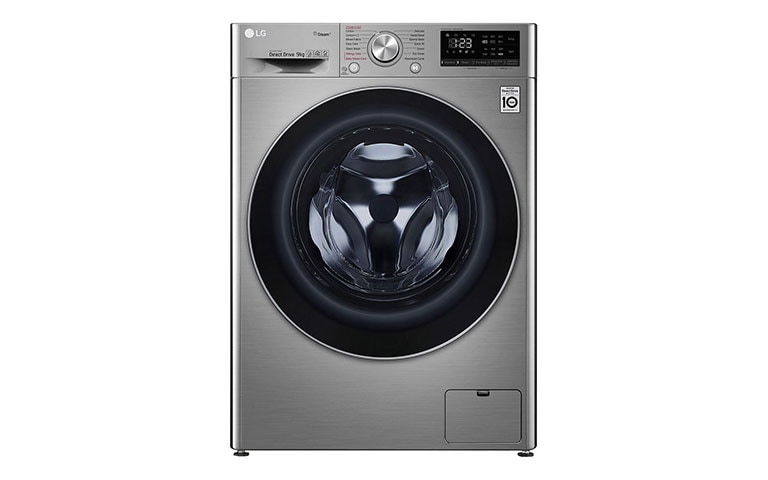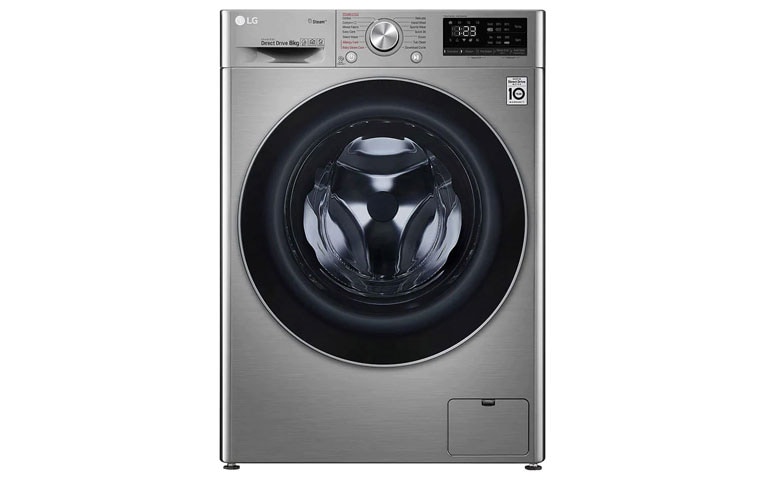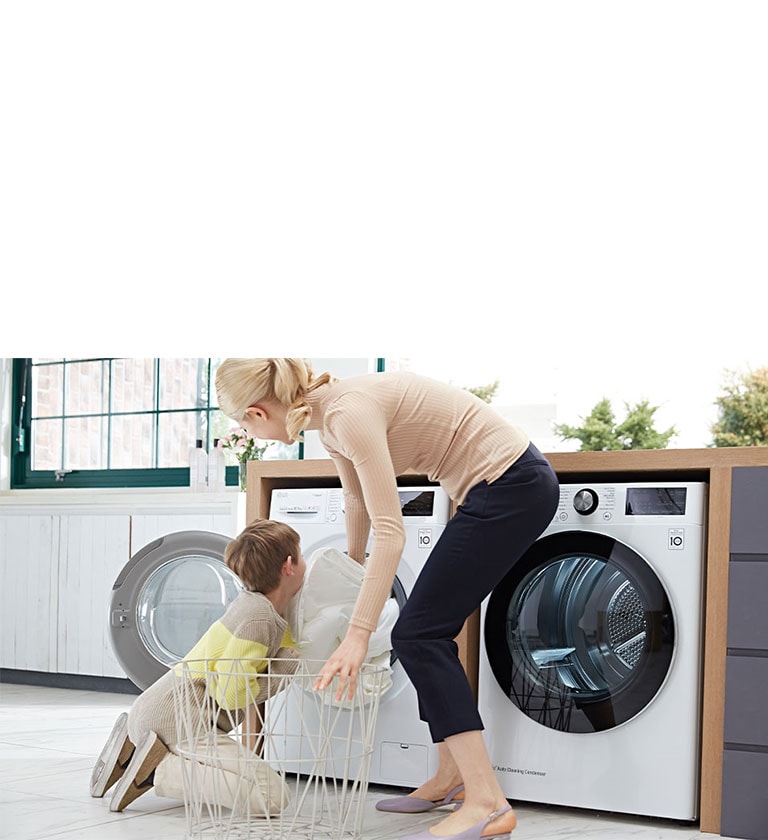-
Washing Machine cleaning maintenance can feel disheartening, when you have to combat smells, mould and blockages. However, it doesn’t have to be. The key to keeping your Washing Machine clean is all down to staying on top of it - regularly making sure you’re looking after your appliance.
What’s more, many Washing Machines actually make this process a bit easier for you, with smart technologies enabled to help you clean your machine without the hassle. Many of LG’s Washing Machines offer a TubClean facility making appliance cleaning easier than ever before. However, if you have an older appliance or just don’t know how to get that smell out of your Washing Machine- we've compiled the best fool-proof hacks to keep the dirt at bay.
The team at LG has put together a Washing Machine cleaning guide to give you the best helpful tips and tricks to keep on top of your Washing Machine hygiene.
-
1. 5 steps for cleaning front load Washing Machines
-
Front loading Washing Machine


-
1. The Washing Machine Detergent Drawer


-
To clean the detergent drawer, firstly switch your machine off, then pull the drawer out as far are you can before getting any resistance. Then push down on the blue button to fully release the drawer and remove it from the machine. Soak the drawer in a bowl of hot water, you can add dishwasher liquid or vinegar if you’re looking for that extra level of cleanliness.
Whilst the drawer is soaking in your hot water mix, make sure to wipe down and clean out the inside of the detergent drawer – you can do this with a microfibre cloth with some water and vinegar. It’s important to get into the top of the compartment as this is where most of the mouldy and dirt builds up. If you have any dirt stuck in crevices, use a toothbrush to release those final unwanted bits.
Meanwhile your detergent drawer should have soaked for long enough to release any built-up mould and soap scum, which you can now remove with a cloth or sponge. Once you have finished scrubbing rinse your drawer in warm water and dry off completely before re-inserting into the machine.
-
2. The Washing Machine Drain filter


-
Before you begin cleaning your Washing Machine filter check to see if it has a self-cleaning filter located underneath the agitator, if it does it’s worth noting that it needs to be cleaned less frequently than a standard filter.
To begin, switch off your Washing Machine and remove the cover panel in the bottom corner on the outside of the Washing Machine, if you cannot locate the filter then check the manual. To remove your filter, twist the cap on the outside and it should easily pull out of place. If it feels stuck, try to gently manipulate it by moving it around loosening up any lint or built-up detergent.
When you remove the filter, it will likely be covered in a layer of wet liquid. Use a paper towel to remove the debris and excess liquid – this will take away any built-up detergent and lint on the outside. Once you have removed all debris, remove the screen and soak it in a bowl of hot water for 10 minutes to soften and remove any lingering detergent, fabric conditioner or lint that could not be cleared.
Before replacing the filter into the machine check the inside machine for any loose lint, use a sponge or cloth to remove any residue. Then replace the filter making sure to screw it in correctly and then replace the cover to make sure it is secure.
-
3. The Washing Machine Drum


-
To best clean the Washing Machine Drum make sure the machine is empty and switched off. Then spray the inside of the drum down with white wine vinegar and wipe it down with a microfibre cloth. Make sure not to do this too frequently, especially near the seal of the machine as the vinegar can corrode the rubber seal.
-
4. The Washing Machine Rubber Seal


-
The biggest culprit for bad smells coming from your Washing Machine is the seal, as it is the place that most mould and dirt builds up because it’s the final barrier to stop your Washing Machine, leading to high moisture levels.
One of the most effective ways to clean your seal is to add 100g of baking soda directly into the drum of your Washing Machine and running it on an empty cycle at 90 degrees Celsius. Once the cycle is finished use a cloth with some warm water and washing up liquid to remove any excess dirt built up under the seal, not released in the wash.
Alternative methods to clean your Washing Machine seal include using white vinegar and a cotton bud or cautiously using bleach round the seal.
-
5. Front Loading Washing Machine Exterior


-
To keep the exterior of your Washing Machine you can use a variety of different products. One of the simplest ways is to use an antibacterial spray or white vinegar on the exterior and wipe it down with a cloth to get rid of any dirt or germs.
If you have a stainless steel exterior Washing Machine, such as the LG F2V5PYP2T you may want to invest in a stainless-steel spray so that you can ensure you get the smoothest finish with no unwanted marks or spray residue.
-
2. 10 essential Washing Machine cleaning tips
-
1. Invest in white vinegar and baking soda for your cleaning supplies
White vinegar and bicarb will become staples of your cleaning artillery and they have multiple uses across the machine, the dispenser and the drum - both products can also help to eliminate odours and get rid of any unwanted mould in your machine.
-
2. Use washing up liquid or dishwasher soap to keep on top of mould and mildew
Using soapy water and a cloth is a quick fix to keep on top of any dirt and mould that builds up as a result of excess moisture in the seal. This can save you from further work down the line having to deep clean the seal.
-
3. Avoid overusing bleach in the machine
Bleach when used in excess can damage the machine so it's important to make sure that you are not overusing it when cleaning. What’s more it can be difficult to fully clear out of the washer, and if you do not empty it properly it could lead to damage in your clothes.
-
4. Make sure to clean your machine regularly
It's advisable to clean your machine at least twice a year, and more regularly can be beneficial. If you keep on top of your machine cleaning, you can prevent damage to your machine and keep it performing at optimal capacity.
-
5. Use your laundry detergent to clean your machine
If you do not have any cleaning products to hand one way to clean your machine is using your normal laundry detergent on the longest cycle available. Especially using biological detergent can help keep your machine clean as the active enzymes in it help to break down any dirt or bacteria.
-
6. See if you Washing Machine has a cleaning cycle setting
All our LG Washing Machines have a TubClean setting which you can enable to keep your machine clean. Please check for more information on how to get the most out of TubClean.
-
7. Use Sodium Percarbonate to get rid of any bad smells
Sodium percarbonate, sometimes called ‘laundry bleach’ or ‘oxygen bleach’ is another way that you can alleviate bad smells in your machine. The benefit of sodium percarbonate is that it is stronger that baking soda but it is safer to use than liquid bleach, as it eliminates most of the risks that come with using sodium hyperchlorite.
-
8. White Vinegar or Washing Machine Tablets can eliminate limescale build up
If you live in an area that has hard water or you frequently see a limescale build up in your machine, using these anti-limescale solutions can help protect your machine for longer and as a result protect your laundry from any discolouration that comes as a result.
-
9. Stop smells by regularly airing out your machine
You can stop your Washing Machine from producing bad smells by airing out the dispenser drawer and the drum. This helps stop the moisture build up that causes mould and mildew which are often responsible for the bad smells coming from your machine.
-
10. Buy your cleaning products in bulk
To save on money and time, invest in your cleaning products in bulk. This way you can get more for your money and have a long-lasting cleaning supply.
3. FAQs
-
Q.
Can you mix bleach and baking soda to clean Washing Machine?
-
A.Mixing bleach and baking soda has no harmful effects, and baking soda is one of the very few cleaning agents considered safe to mix with bleach. The combination of bleach (in the detergent compartment) and baking soda (in the drum) make for a powerful whitening, cleaning combination when maintaining your Washing Machine. Be sure to take safety precautions when using bleach such as working in a well-ventilated area, wearing rubber gloves and even considering goggles for eye protection.
-
Q.
How to clean a Washing Machine with vinegar and baking soda?
-
A.1. Add four cups of white vinegar to the Washing Machine and start a cycle on its highest and hottest setting – although once its filled up and barely started, pause it to let the water and vinegar sit for an hour.
2. Whilst you wait, wipe down the lid and the rest of the Washing Machine using a spritz of vinegar on a cloth.
3. Focus in on the detergent and fabric softener dispenser – using a toothbrush can come in handy to get openings fresh and clean.
4. Once first cycle has finished, add a cup of baking soda and run another powerful cycle.
5. Leave the lid open and let it air dry out, you can also use a dry cloth to help wipe it out.
-
Q.
How to clean a Washing Machine with Vitamin C?
-
A.Citric acid and ascorbic acid (commonly known as vitamin C) are reducing or chelating agents, which makes them particularly effective for cleaning build-up associated with hard water – rust, limescale, and soap scum or detergent build-up.
Bring a pan of water to the boil, take off the heat, and dissolve approximately 200 grams of ascorbic acid powder and 100 grams of citric acid powder in the water. Add the warm solution directly to the drum of your machine and pour a little into the tray. Run the machine on a hot wash without any clothes. Don't use citric acid undiluted on plastic Washing Machine trays as it could cause damage.
-
Q.
How to clean a Washing Machine's detergent drawer?
-
A.Start by removing your Washing Machine detergent drawer – this will need to be cleaned separately in the sink. Use your bathroom cleaner of choice, topped up with a little water to fill the scrubbing sponge and then start scrubbing the drawer. Use warm water to help loosen soap scum quicker. Use bicarbonate of soda to remove odours, place a tablespoon of bicarbonate of soda into the drawer space and spray it with white vinegar. The powder will then froth up and start trickling down the pipe – the reaction of the vinegar and bicarb will neutralise any odours and should lift away any residual grime.
-
Q.
How to clean and sanitise the wash drum?
-
A.Add one cup of Epsom Salts to half a cup of vinegar, or even water, and add directly to the drum. Run the machine on its hottest cycle, pausing at the beginning to let the saline solution soak. Once the cycle is over the machine should be clean and good for use.
-
Q.
How do you clean Washing Machine rubber seal?
-
A.Add one cup of baking soda to one cup of bleach and pour in the detergent drawer. Then add one cup of baking soda to the seal inside the Washing Machine and run on the hottest setting. Once complete, wipe the seal with a cloth soaked in soapy water.
-
Q.
Is bleach or vinegar better to clean Washing Machine?
-
A.The best way to clean your machine is to use both bleach and vinegar – but NEVER together as they produce toxic fumes. Put the bleach in the drum first and the vinegar in the conditioner drawer after the bleach has been washed out. Make sure it is white vinegar and non-chlorinated bleach that you are using.
-
Q.
Can vinegar damage your Washing Machine?
-
A.Yes, vinegar can harm rubber parts inside a Washing Machine, which will eventually lead to leaks if used too often. Whilst washing your clothes with vinegar is a cost-effective, natural way to soften and deodorize fabrics, avoid using it in your washer too frequently. Only use it sporadically when deep cleaning the machine.




